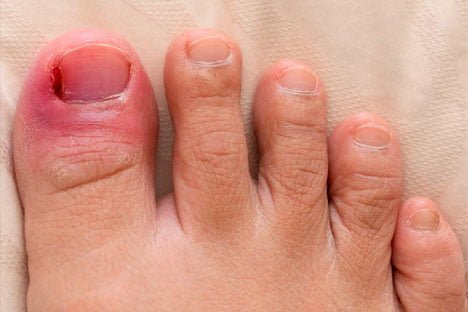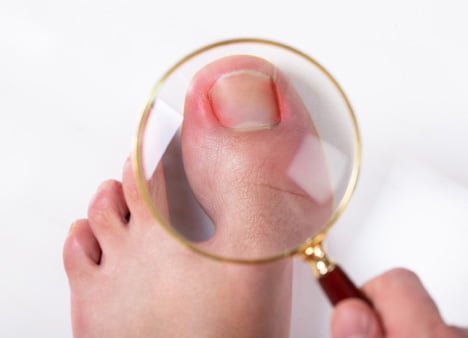Ingrown Toenail Surgery
 Ingrown toenails are very common in pediatric and adult patients. An ingrown nail occurs when the corner of a nail grows into the skin, causing pain, redness, and often even infection in the surrounding skin. Ingrown toenails should be treated in the office of your foot doctor in NYC to avoid further complications. If this is a chronic recurring issue, your foot doctor in NYC has a number of treatment options to prevent your ingrown nail from returning permanently.
Ingrown toenails are very common in pediatric and adult patients. An ingrown nail occurs when the corner of a nail grows into the skin, causing pain, redness, and often even infection in the surrounding skin. Ingrown toenails should be treated in the office of your foot doctor in NYC to avoid further complications. If this is a chronic recurring issue, your foot doctor in NYC has a number of treatment options to prevent your ingrown nail from returning permanently.
All symptoms, potential procedural/surgical options should always be discussed with your podiatrist after a thorough consultation and examination for an accurate diagnosis and treatment plan.
”
★ ★ ★ ★ ★A doctor displays a great understanding of what it means to be a professional and epitomizes the word “sincerity.” Extremely caring and informative goes above and beyond to make sure his patient is comfortable. If you need a podiatrist, look no further!
The Anatomy of the Toe
Your nail consists of visible and hidden portions. Under the cuticle and the proximal nail fold, you will find the root of the nail. The root is where the cells that produce the nail plate sit. Sometimes, these cells can become damaged through trauma or tight shoes and begin to produce a thickened or abnormal nail in shape. Center for Podiatry in New York and frankly worldwide encounter patients with ingrown nails and other nail problems pretty much every day. Your NYC foot doctor can diagnose and treat your ingrown nail and answer any questions you have about your condition.
Causes of Ingrown Toenail
It is important to consider the cause of your ingrown nail rather than just treating the problem, and you can count on your Midtown NYC foot doctor to make a proper diagnosis. The causes that can lead to an ingrown toenail include:
- Incorrect toenail trimming: When toenails are cut too short, or the edges are trimmed, the skin can push over the top of the nails, and the nails grow into the skin.
- Poor-fitting shoes: Wearing too-tight shoes can increase the pressure on the skin around your nails. Your toenail can puncture your skin if pressed into the flesh for too long.
- Physical damage: Stubbed toes can occasionally promote ingrown nails.
- Foot perspiration: Feet inside non-breathable shoes becomes moist with sweat, which causes the skin to soften and allows the toenail to penetrate more easily.
- Nail shape: Curved nails tend to dig into the skin more often than square-shaped ones.
- Nail infections: Fungal infections can thicken toenails to the point where they pierce the flesh.
Prevention of Ingrown Toenails
If an ingrown toenail is untreated, it can become infected. Your good podiatrist suggests some simple ways to prevent ingrown nails:
- Wash your feet regularly to keep them clean.
- Cut your nails straight to prevent them from growing underneath adjacent skin.
- Keep your feet dry by changing socks often.
- Wear shoes that are wide and comfortable
Generally, a podiatric doctor will start with a simple office procedure to remove the offending nail under local anesthesia. If an infection is present, antibiotics may be necessary.
Partial Nail Avulsion

The partial nail avulsion — the removal of part of the toenail — is a surgical procedure that’s very common for treating ingrown toenails. The best foot doctor in NYC has reported over 95 percent success rates with this common procedure.
Partial nail avulsions may be performed with only a local anesthetic to numb your toe. The side of the nail can then safely and painlessly be removed. Phenol is a chemical used to prevent nail growth and may kill the nail root in patients with recurrent ingrown nails. Antibiotics are generally prescribed following this procedure if pus is draining.
Total Nail Avulsion
In some rare cases, a total nail avulsion may be necessary. This is a procedure to remove your toenail completely. Your podiatric doctor in NYC generally avoids this procedure since your nail is important to protect your toe from damage. In some cases, this procedure is necessary if the nail grows upward or in a direction where it is doing more harm than good. You may also need a total nail avulsion if an infection is trapped under the toe or if you have blood trapped under the nail. Following the procedure, you end up with an indentation where the nail used to be. If the nail root is not destroyed with chemical or surgical means, the nail will grow back.
Matrixectomy
If your foot doctor in NYC believes your toenail will become ingrown again, a partial or complete matrixectomy may be indicated. A Matrixectomy is a procedure resulting in permanently removing a portion of the nail matrix, preventing further growth at that site. A matrixectomy is a procedure resulting in permanent destruction of the nail matrix by several possible methods:
- Applying chemicals such as the aforementioned phenol to the nail matrix.
- Burning the matrix with electricity, a process called electrocautery ablation, or laser equipment are also effective methods, although more expensive.
- The cells that produce the nail can be surgically removed, preventing nail growth.
Complications from Ingrown Toenail Surgery
The simplicity of the surgery is such that complications are unusual. However, podiatrists report that partial regrowth of the toenail can happen after a failed matrixectomy.
Additionally, infections are possible after any surgery. The recovery depends on the procedure type you have, which can be as short as a week to up to a month. Complications can always occur and increase in recovery time.
After Ingrown Toenail Surgery
Post-operative treatment varies depending on the specific procedure you receive, so please consult your doctor for specific detailed post-operative instructions.
After your surgery, you’re typically sent home with a bandaged toe. You’re instructed to keep your foot elevated for the next day or two. You may have to wear special footwear for a couple of weeks to allow your toe to heal properly. Our Podiatrists are highest rated NYC foot doctors who often recommend wearing a surgical shoe during the recovery period. Follow your podiatrist’s instructions completely because the nail is very close to the underlying bone, and any infection could spread to the bone, complicating the treatment extensively.
Between the first and second week following the surgery, visit your foot doctor in New York City to verify that no infections have developed, clean the surgical site, and change the bandage. You may be prescribed antibiotics and medicine to control pain. You should feel much better after just a few days and return to normal activity within a couple of weeks and often much quicker, depending on the procedure performed.
Do you have any questions about the Ingrown Toenail Surgery procedure in NYC? Would you like to schedule an appointment with an internationally recognized, top NYC Podiatrist and foot doctor at Manhattan Foot Specialists? Please contact our office for a consultation.
Manhattan Foot Specialists (Midtown) 56 W 45th St, Ste 802, New York 10036
Manhattan Foot Specialists (Union Square) 55 W 17th St Ste 102, New York 10011
Manhattan Foot Specialists (Financial District) 80 Maiden Lane, Ste 1204, New York 10038
